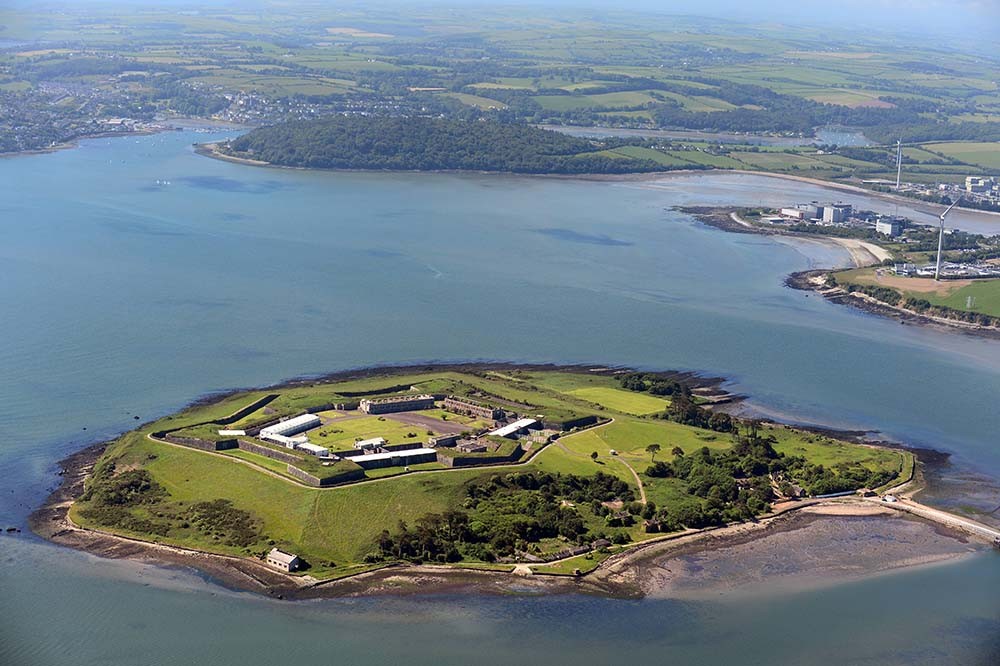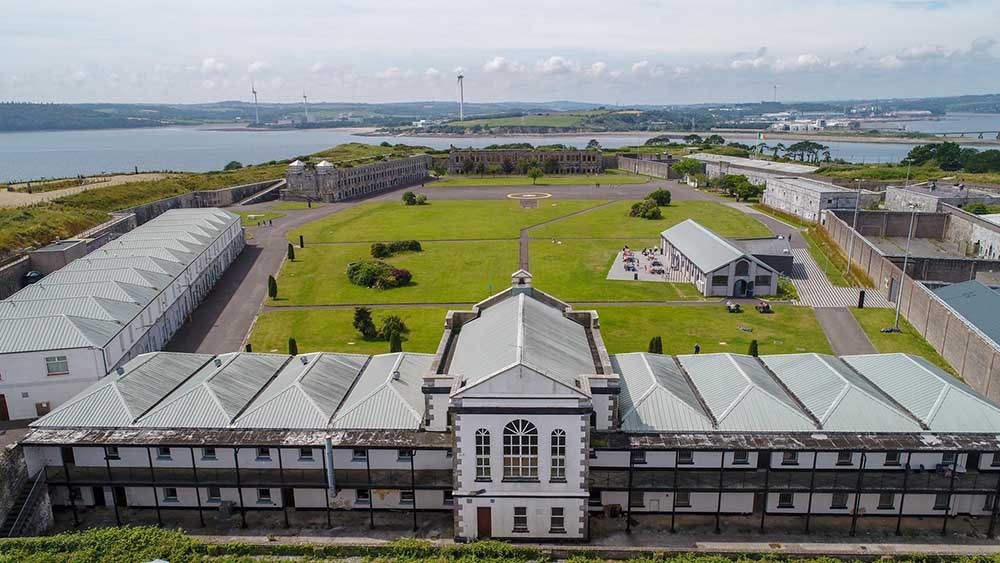
Today marks 100 years to the day of the opening of the Military prison in the field on Spike island.
The prison was opened to house Irish rebels engaged in the bloody War of Independence that raged from 1919 to 1921. As many as 1200 prisoners and internees were held on the island, with up to 500 at any one time.
There were prison riots, hunger strikes and daring escapes, and not all would leave the island alive. At least 25 Clare men were held on the island for their involvement in the struggle for freedom, including Meelick man Patrick White who was shot and died while playing hurling in May of 1921.
Spike Island, the War of Independence
On the 19th of February 1921 as the Irish War of Independence raged, a British Military Prison was opened on Spike Island for Republican prisoners and internees. The bloody struggle for Irish Independence was seeing huge numbers arrested for insurgency activity, and the British needed somewhere to hold them. Spike Island was again the answer to a spiralling British prisoner problem, having been used as a prison by Cromwell in the 1600’s and as a convict prison during the famine years of the 1840’s.
Republican prisoners and internees were sent to Spike Island from the civilian gaols in Cork, Kilkenny, Waterford and Limerick and from the military barrack and camps in Bere Island, Buttevant, Cork, Fermoy, Kilkenny, Kilworth, Moore Park, Tralee and Waterford. In total men from eight southern counties were held on the island and at its largest the prison held over 500 men.
Prisoners were men arrested by Crown Forces and later charged, tried, convicted and sentenced to imprisonment by Military Courts. Internees were men arrested on suspicion of their involvement in Republican activities and imprisoned without trial. There were approximately 900 internees and 300 prisoners held on Spike Island during 1921.
Of the 1200 held there were approximately twenty-five Clare rebels on Spike Island, men from almost every town in County Clare. Some of these were, Dr John Holmes from Scariff, William McNamara from Ennis, John Joe Neylon from Kilfenora, Thomas Ringrose from Meelick and Tom Shalloo from Ennistymon. Tragically for one Clare man the sentence on Spike Island was fatal, as on the evening of the 31st of May, internee Patrick White from Meelick, Co. Clare, was shot and killed by a British sentry while playing hurling. Some Clare rebels were also held in camps on Bere island and Kilworth.
During 1921 there were two dramatic escapes from Spike Island involving ten republicans. On the 30th of August, a hunger strike began for unconditional release, lasting four days before being abandoned. On the 16th of October, the internees began rioting and breaking up their huts, to force the British military authorities to release them. When the British soldiers regained control, they forced the internees out into the dry moat, where they endured three cold, wet days and nights without shelter.
On the night of the 16/17th of November, the last republican prisoners were moved from Spike Island to Kilkenny Gaol. On the 18th of November all the internees from Spike Island were taken to Cobh and transferred by special train to Maryborough (Portlaoise) Prison. The Spike Island Military Prison in the Field was closed.
Island historian Tom O’Neill said “We have been researching and planning for this commemoration for close to a decade, painstakingly tracking down the available information, much of which is now located in London. The period is an important part of the island and Ireland’s history, and we look forward to sharing it with the world”.

‘Imprisoning a Nation’ exhibition on Spike Island
To commemorate the lives of the 1200 men held on the island, Spike Island is launching an exhibition entitled ‘Imprisoning a Nation’. The exhibition will focus on the 1921 prison and the stories of the rebels held there are told in great detail. The exhibition is an extension of the island permanent ‘Independence’ exhibition, which tells of the wider Irish independence ‘road to freedom’ from 1914 to 1921.
The island was brought into the story of the 1916 Easter rising when the crew of the Aud were held there, a German gun running ship which was intended to supply the rising with arms and ammunition. The tri-lingual Aud exhibition, told in Irish, English and German, includes some original ‘Aud’ artefacts recovered from the seabed. The story continues to the outbreak of the War of Independence in 1919 and culminates in the story of Spike Island’s 1921 prison and its approximately 1,200 republican prisoners and internee.
There are original autograph books, medals and other artefacts connected with the men held on Spike Island. There are also approximately one hundred and fifty photographs of the men held on display, and the exhibition puts a real connectable face to the names. There are two very detailed databases available for use by visitors where they can research the story of the men, finding them by surname, birth county and place of arrest.
2021 Centenary plans – To commemorate the centenary in 2021, It is planned to hold a principal commemoration during the June bank holiday weekend which is being funded by the Cork County Council Commemoration grant scheme, Covid conditions allowing. In addition, it is intended to commemorate the other events that occurred on Spike during 1921, including the escapes, the shooting of internee Patrick White, the hunger strikes, etc.
Quite a few of the families of the men are planning to hold their own special commemorations on Spike on the centenary of the date when their relatives were transferred to the island, and many have already been liaising with the islands heritage team to plan their special events. Families are expected from as far away as Australia to celebrate their connection to the island.
Island manager John Crotty said: “The response from the public has been considerable with a large amount of people volunteering original autograph books, artefacts and information about their relatives. Many people have discovered unknown links to rebels within their own families, which is a credit to the island research team. We would encourage anyone with any artefacts or story connected to the island to contact us, so we can catalogue the details”.

Spike Island continues to grow
In July 2010, the island was handed over to Cork County Council to be developed into a tourist attraction, opening its doors in 2016 following a €6.5 million Euro upgrade. Since then with the backing of owners Cork County Council and assistance of Fáilte Ireland, the wonderful heritage of Spike Island has been developed and expertly interpreted. Visitors numbers have grown from 27000 to over 81000 in 2019. Covid decimated numbers in 2020 with a 52% drop to 39000.
The island has a rich history including use a monastery in the 7th century and saw centuries of quiet farming life. The eyes of the world turned to the 104 acre outcrop in the late 1700’s when the British built the first of three forts on the island, built to defend the world’s largest navy and protect the world’s second largest natural harbour. The third fort started in 1804 is the 24 acre colossal that stands to this day, one of the largest star shaped forts in the world. That same fort became a prison during the famine years and its convict numbers swelled to over 2300, making it the largest known prison in the world and the largest ever in Ireland or Britain. It returned to military use in the 1880’s and after the 1921 prison opened and closed, another 17 years of British occupation followed. In 1938 the island was handed from Britain to Ireland and it was occupied by the Irish Army until 1979 and the Irish Navy until 1985. A 4th and final prison operated from 1985 to 2004. Visitors today can learn about this rich history in several museums, exhibitions and original buildings, including the Gun Park where a comprehensive collection of original artillery guns and vehicle are displayed. Visitors can also walk the halls of the ‘Punishment block’, the original 1850’s prison, and the modern cells built following a riot on the island in 1985.
The island is anticipating high staycation demand in 2021 as visitors shun risky foreign travel and rediscover their own heritage, particularly in this centenary year.